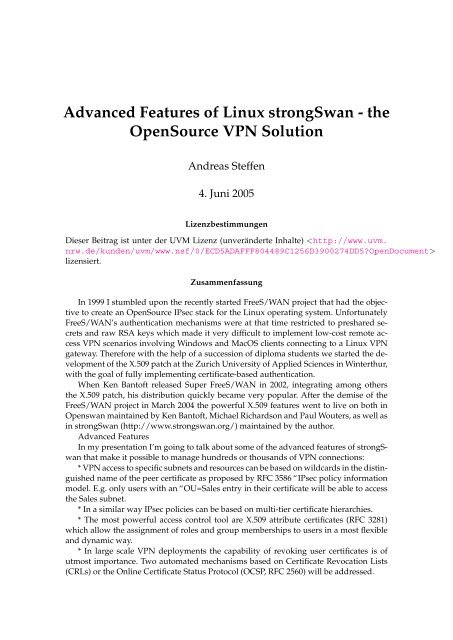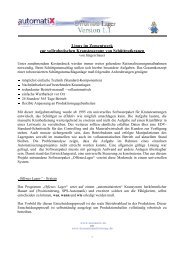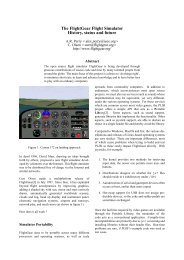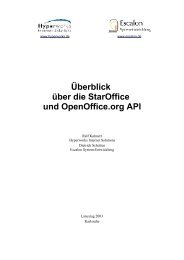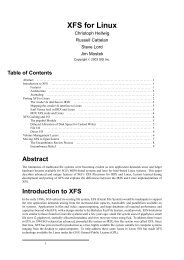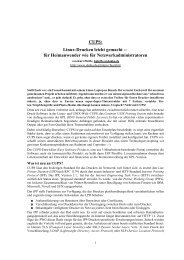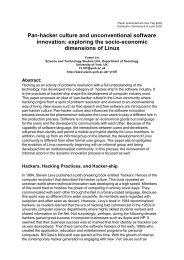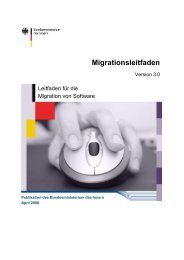Advanced Features of Linux strongSwan - the OpenSource VPN ...
Advanced Features of Linux strongSwan - the OpenSource VPN ...
Advanced Features of Linux strongSwan - the OpenSource VPN ...
You also want an ePaper? Increase the reach of your titles
YUMPU automatically turns print PDFs into web optimized ePapers that Google loves.
<strong>Advanced</strong> <strong>Features</strong> <strong>of</strong> <strong>Linux</strong> <strong>strongSwan</strong> - <strong>the</strong><br />
<strong>OpenSource</strong> <strong>VPN</strong> Solution<br />
Andreas Steffen<br />
4. Juni 2005<br />
Lizenzbestimmungen<br />
Dieser Beitrag ist unter der UVM Lizenz (unveränderte Inhalte) <br />
lizensiert.<br />
Zusammenfassung<br />
In 1999 I stumbled upon <strong>the</strong> recently started FreeS/WAN project that had <strong>the</strong> objective<br />
to create an <strong>OpenSource</strong> IPsec stack for <strong>the</strong> <strong>Linux</strong> operating system. Unfortunately<br />
FreeS/WAN’s au<strong>the</strong>ntication mechanisms were at that time restricted to preshared secrets<br />
and raw RSA keys which made it very difficult to implement low-cost remote access<br />
<strong>VPN</strong> scenarios involving Windows and MacOS clients connecting to a <strong>Linux</strong> <strong>VPN</strong><br />
gateway. Therefore with <strong>the</strong> help <strong>of</strong> a succession <strong>of</strong> diploma students we started <strong>the</strong> development<br />
<strong>of</strong> <strong>the</strong> X.509 patch at <strong>the</strong> Zurich University <strong>of</strong> Applied Sciences in Winterthur,<br />
with <strong>the</strong> goal <strong>of</strong> fully implementing certificate-based au<strong>the</strong>ntication.<br />
When Ken Bant<strong>of</strong>t released Super FreeS/WAN in 2002, integrating among o<strong>the</strong>rs<br />
<strong>the</strong> X.509 patch, his distribution quickly became very popular. After <strong>the</strong> demise <strong>of</strong> <strong>the</strong><br />
FreeS/WAN project in March 2004 <strong>the</strong> powerful X.509 features went to live on both in<br />
Openswan maintained by Ken Bant<strong>of</strong>t, Michael Richardson and Paul Wouters, as well as<br />
in <strong>strongSwan</strong> (http://www.strongswan.org/) maintained by <strong>the</strong> author.<br />
<strong>Advanced</strong> <strong>Features</strong><br />
In my presentation I’m going to talk about some <strong>of</strong> <strong>the</strong> advanced features <strong>of</strong> <strong>strongSwan</strong><br />
that make it possible to manage hundreds or thousands <strong>of</strong> <strong>VPN</strong> connections:<br />
* <strong>VPN</strong> access to specific subnets and resources can be based on wildcards in <strong>the</strong> distinguished<br />
name <strong>of</strong> <strong>the</strong> peer certificate as proposed by RFC 3586 “IPsec policy information<br />
model. E.g. only users with an “OU=Sales entry in <strong>the</strong>ir certificate will be able to access<br />
<strong>the</strong> Sales subnet.<br />
* In a similar way IPsec policies can be based on multi-tier certificate hierarchies.<br />
* The most powerful access control tool are X.509 attribute certificates (RFC 3281)<br />
which allow <strong>the</strong> assignment <strong>of</strong> roles and group memberships to users in a most flexible<br />
and dynamic way.<br />
* In large scale <strong>VPN</strong> deployments <strong>the</strong> capability <strong>of</strong> revoking user certificates is <strong>of</strong><br />
utmost importance. Two automated mechanisms based on Certificate Revocation Lists<br />
(CRLs) or <strong>the</strong> Online Certificate Status Protocol (OCSP, RFC 2560) will be addressed.
* In remote access setups where roadwarrior using dynamic IP addresses want to<br />
connect to <strong>the</strong>ir home base, <strong>the</strong> possibility <strong>of</strong> assigning a virtual IP address for use within<br />
<strong>the</strong> <strong>VPN</strong> tunnel is a major requirement. Both static and dynamic virtual IP assignments<br />
methods will be discussed (iproute2-based source routing, DHCP-over-IPsec, IKE Mode<br />
Config).<br />
* In order to minimize <strong>the</strong> risk <strong>of</strong> compromising <strong>the</strong>ir IPsec credentials in <strong>the</strong> case<br />
<strong>of</strong> <strong>the</strong>ft or loss, roadwarrior clients should store <strong>the</strong>ir private RSA keys on a smartcard<br />
or USB cryptotoken. <strong>strongSwan</strong> has an integrated OpenSC (http://www.opensc.org/)<br />
smartcard interface.<br />
* Dead Peer Detection (DPD, RFC 3706) is a relatively new feature that can be used to<br />
monitor <strong>the</strong> liveliness <strong>of</strong> an IPsec tunnel. DPD keep-alives in combination with <strong>the</strong> <strong>Linux</strong><br />
High-Availability (http://www.linux-ha.org/) mechanisms make it possible to realize a<br />
redundant <strong>VPN</strong> gateway in a remote access environment.<br />
User-Mode-<strong>Linux</strong> Testing Environment<br />
Michael Richardson brought UML-based regression tests to <strong>the</strong> FreeS/WAN project<br />
when he took over <strong>the</strong> project management some years ago. Unfortunately <strong>the</strong> existing<br />
FreeS/WAN scripts are ra<strong>the</strong>r cryptic and not user-friendly at all. Therefore Eric Marchionni<br />
and Patric Rayo, both recent graduates from <strong>the</strong> Zurich University <strong>of</strong> Applied<br />
Sciences in Winterthur, started from scratch and created a new UML testing environment<br />
for <strong>strongSwan</strong> that can be used both for s<strong>of</strong>tware regression tests in automated<br />
mode as well as for exploring and debugging complex network setups in manual mode.<br />
Among <strong>the</strong> more complex scenarios that can be tested in a virtual environment are e.g.<br />
single and double NAT-ed roadwarrior connections. My talk will include a short demo<br />
<strong>of</strong> <strong>the</strong> <strong>strongSwan</strong> UML testing environment (http://www.strongswan.org/uml/)<br />
1 IPsec-based Virtual Private Networks<br />
Figure 1 shows a typical <strong>VPN</strong> scenario where two subnets 10.1.0.0/16 and 10.2.0.0/16 possessing<br />
private network addresses are connected with each o<strong>the</strong>r over <strong>the</strong> Internet by means<br />
<strong>of</strong> a site-to-site <strong>VPN</strong> tunnel. The tunnel is established between <strong>the</strong> <strong>VPN</strong> gateways 11.22.33.44<br />
and 55.66.77.88 which automatically encrypt and au<strong>the</strong>nticate each packet that is being exchanged<br />
between <strong>the</strong> two networks.
Figure 1: Typical <strong>VPN</strong> scenario<br />
The second much more challenging scenario depicted in Figure 1 is remote access. So called<br />
” road warriors“, equipped with dynamical IP addresses assigned by <strong>the</strong>ir local Internet Service<br />
Providers (ISPs) are able to build up a <strong>VPN</strong> tunnel to <strong>the</strong> security gateway 11.22.33.44<br />
from any point <strong>of</strong> <strong>the</strong> Internet using ei<strong>the</strong>r fixed connections, public WLAN hot spots or mobile<br />
communication channels. Thus <strong>the</strong> remote access clients get full access to all resources<br />
in <strong>the</strong> 10.1.0.0/16 network as if <strong>the</strong>y were located right at Head Quarters.<br />
We will come back to <strong>the</strong> special properties <strong>of</strong> <strong>the</strong> road warrior case later in this paper and<br />
continue by first giving a short overview on <strong>the</strong> IPsec standard which basically consists <strong>of</strong><br />
two parts:<br />
• The actual encryption and au<strong>the</strong>ntication <strong>of</strong> tunneled IP packets takes place in <strong>the</strong><br />
kernel using <strong>the</strong> Encapsulating Security Payload (ESP) standard defined by RFC 2406.<br />
ESP is IP protocol 50 and doesn’t have ports.<br />
• The initial negotiation and <strong>the</strong> ensuing periodic re-keying <strong>of</strong> IPsec tunnels is done by<br />
a userland daemon running <strong>the</strong> Internet Key Exchange (IKE) protocol defined by RFCs<br />
2407, 2408, and 2409. IKE is transported over UDP datagrams and must use <strong>the</strong> wellknown<br />
source and destination port 500.<br />
1.1 The IPsec Kernel Part - ESP<br />
The ESP encapsulation <strong>of</strong> IP packets is shown in figure 2. Referring to <strong>the</strong> site-to-site <strong>VPN</strong><br />
scenario depicted in figure 1, a TCP packet exchanged between a host 10.1.0.5 in <strong>the</strong> 10.1.0.0/16<br />
network and a host 10.2.0.7 in <strong>the</strong> 10.2.0.0/16 network will carry <strong>the</strong>se two addresses as source<br />
and destination in <strong>the</strong> original IP header, whereas <strong>the</strong> outer IP header <strong>of</strong> <strong>the</strong> IPsec packet<br />
will contain <strong>the</strong> addresses 11.22.33.44 and 55.66.77.88 <strong>of</strong> <strong>the</strong> <strong>VPN</strong> gateways that do <strong>the</strong> actual<br />
tunneling. ESP encrypts <strong>the</strong> whole original IP packet including <strong>the</strong> internal header and secures<br />
<strong>the</strong> encrypted content against unauthorized modification by computing and appending<br />
a cryptographic checksum.
Figure 2: IPsec Encapsulating Security Payload (ESP)<br />
Depending on <strong>the</strong> <strong>Linux</strong> kernel version, <strong>strongSwan</strong> employs different mechanisms to implement<br />
<strong>the</strong> IPsec kernel part:<br />
• Under a <strong>Linux</strong> 2.4 kernel, KLIPS from <strong>the</strong> FreeS/WAN project is used to implement<br />
<strong>the</strong> IPsec kernel functionality. KLIPS, distributed as part <strong>of</strong> <strong>strongSwan</strong>, can ei<strong>the</strong>r be<br />
compiled statically into <strong>the</strong> kernel or loaded dynamically as a kernel module ipsec.o.<br />
For encryption, au<strong>the</strong>ntication and compression, built-in functions from <strong>the</strong> FreeS/WAN<br />
project and/or crypto modules provided by JuanJo Ciarlante are used.<br />
• Under a <strong>Linux</strong> 2.6 kernel, <strong>the</strong> native KAME stack ported from <strong>the</strong> BSD project to <strong>Linux</strong><br />
is used. Encryption, au<strong>the</strong>ntication and compression tasks use <strong>the</strong> standard modules<br />
<strong>of</strong>fered by <strong>the</strong> kernel’s crypto API.<br />
1.2 The IPsec Userland Part - IKE<br />
<strong>strongSwan</strong>’s userland daemon pluto is responsible for setting up, re-keying and deleting<br />
IPsec tunnels using <strong>the</strong> standardized Internet Key Exchange (IKE) protocol. An IKE negotiation<br />
is divided into Phase 1 where <strong>the</strong> <strong>VPN</strong> peers do mutual au<strong>the</strong>ntication, followed by<br />
one or several Phase 2 exchanges where <strong>the</strong> encryption, au<strong>the</strong>ntication and compression parameters<br />
for <strong>the</strong> actual tunneling <strong>of</strong> IP packets between predefined subnets are set up.<br />
<strong>strongSwan</strong> implements IKE Main Mode for Phase 1 and IKE Quick Mode for Phase 2. The<br />
potentially vulnerable IKE Aggressive Mode Phase 1 variant is not supported by <strong>strongSwan</strong><br />
out <strong>of</strong> security considerations. IKE Main Mode peer au<strong>the</strong>ntication can ei<strong>the</strong>r be based on<br />
Pre-Shared Keys (PSK) or on RSA signatures as shown in figure 3.
Figure 3: Internet Key Exchange Protocol (IKE)<br />
IKE Main Mode consists <strong>of</strong> six messages exchanged between <strong>the</strong> <strong>VPN</strong> peers:<br />
1. The initiator proposes a series <strong>of</strong> supported encryption and au<strong>the</strong>ntication transforms<br />
for securing <strong>the</strong> IKE negotiation.<br />
2. The responder selects a set <strong>of</strong> transforms common to both parties.<br />
3. The initiator sends a public Diffie-Hellman factor and a nonce.<br />
4. The responder in turn also sends a public Diffie-Hellman factor and a nonce which is<br />
a random number. Using <strong>the</strong> Diffie-Hellman key exchange algorithm both end points<br />
can now compute a common shared secret that is used to encrypt all ensuing IKE<br />
messages.<br />
5. The initiator sends its identity and a signature computed by encrypting a hash formed<br />
over all exchanged IKE messages with its RSA private key. Although an option in IKE,<br />
<strong>strongSwan</strong> always includes a trusted X.509 certificate that can be used by <strong>the</strong> peer to<br />
verify <strong>the</strong> signature.<br />
6. Now it is <strong>the</strong> responder’s turn to identify and au<strong>the</strong>nticate itself.<br />
Each IKE Quick Mode will <strong>the</strong>n add ano<strong>the</strong>r three messages.<br />
2 From FreeS/WAN to <strong>strongSwan</strong><br />
The FreeS/WAN project (www.freeswan.org ) was founded<br />
in 1999 by John Gilmore with <strong>the</strong> ultimate goal <strong>of</strong> automatically encrypting a significant<br />
part <strong>of</strong> <strong>the</strong> Internet traffic using Opportunistic Encryption (OE) based on IPsec and IKE. The<br />
grand idea behind OE was to do host au<strong>the</strong>ntication using raw RSA public keys fetched via<br />
<strong>the</strong> ubiquitous Domain Name System (DNS).
Because most existing <strong>VPN</strong> implementations did not and still do not support <strong>the</strong> use <strong>of</strong><br />
raw RSA keys, <strong>the</strong> author decided to contribute a X.509 patch to <strong>the</strong> FreeS/WAN project<br />
in order to make it possible for <strong>Linux</strong> hosts to set up IPsec tunnels with any o<strong>the</strong>r <strong>VPN</strong><br />
product using standardized X.509 certificates. The first X.509 patch was released in 2000<br />
and all fur<strong>the</strong>r versions delivered over <strong>the</strong> next four years were developed by <strong>the</strong> author as<br />
pr<strong>of</strong>essor for security and communications at <strong>the</strong> Zürcher Hochschule Winterthur (ZHW)<br />
with major contributions from a whole group <strong>of</strong> diploma students.<br />
In 2002, due to <strong>the</strong> increasing demand for <strong>the</strong> X.509 patch, Ken Bant<strong>of</strong>t bundled it with<br />
several o<strong>the</strong>r FreeS/WAN add-ons like Mathieu Lafon’s NAT traversal patch and JuanJo<br />
Ciarlante’s alternative crypto algorithms and started his Super FreeS/WAN distribution that<br />
quickly became extremely popular.<br />
Figure 4: The FreeS/WAN Genealogy<br />
Towards <strong>the</strong> end <strong>of</strong> 2003 when it became evident that <strong>the</strong> FreeS/WAN project was going to<br />
be discontinued in spring 2004 with <strong>the</strong> final 2.06 release, Ken Bant<strong>of</strong>t, FreeS/WAN project<br />
leader Michael Richardson and Paul Wouters founded Xelerance Corporation with <strong>the</strong> goal<br />
<strong>of</strong> carrying on <strong>the</strong> IPsec development within <strong>the</strong>ir Openswan project (www.openswan.org<br />
).<br />
Whereas Openswan has been moving closer to <strong>the</strong> mainstream <strong>VPN</strong> path by adding IKE<br />
Aggressive Mode and Cisco’s legacy XAUTH au<strong>the</strong>ntication, <strong>the</strong> author decided to fork a<br />
<strong>strongSwan</strong> distribution (www.strongswan.org ) <strong>of</strong><br />
his own in order to be able to quickly integrate and deploy new certificate-based features<br />
originating from <strong>the</strong> Zürcher Hochschule Winterthur.<br />
In March 2005 <strong>the</strong> author accepted an <strong>of</strong>fer to join <strong>the</strong> Hochschule für Technik Rapperswil<br />
(HSR, www.hsr.ch ) where as a pr<strong>of</strong>essor for security and<br />
communications he is now heading <strong>the</strong> Institute for Internet Technologies and Applications<br />
(ITA). Being an important part <strong>of</strong> <strong>the</strong> ITA strategy, <strong>the</strong> maintenance and continuing evolution<br />
<strong>of</strong> <strong>the</strong> <strong>strongSwan</strong> distribution will be guaranteed in <strong>the</strong> years to come.
3 The ” Road Warior“ Remote Access Case<br />
One <strong>of</strong> <strong>strongSwan</strong>’s powerful features inherited from FreeS/WAN is <strong>the</strong> support <strong>of</strong> road<br />
warrior connections as shown in figure 5.<br />
Figure 5: Specific properties <strong>of</strong> <strong>the</strong> road warrior scenario<br />
The following three properties make <strong>the</strong> remote acces case special:<br />
• The IP address <strong>of</strong> a road warrior is nearly always dynamic, i.e. it is usually assigned by<br />
a local ISP, so that a <strong>VPN</strong> gateway cannot get any information on <strong>the</strong> identity <strong>of</strong> <strong>the</strong><br />
remote-access client by looking at <strong>the</strong> source address.<br />
• Since IKE Main Mode with Pre-Shared Keys (PSK) does not work with dynamic addresses<br />
and <strong>the</strong> workaround based on IKE Agressive Mode is insecure, X.509 certificates<br />
should be used to establish <strong>the</strong> identity <strong>of</strong> a road warrior.<br />
• In order to ensure that IP packets originating from <strong>the</strong> home network find <strong>the</strong> way<br />
back through <strong>the</strong> IPsec tunnel and are not mistakenly routed directly into <strong>the</strong> Internet<br />
via <strong>the</strong> default gateway, <strong>the</strong> inner IP address used in <strong>the</strong> tunnel should be set to a<br />
virtual address taken from a special remote-access pool instead <strong>of</strong> being equal to <strong>the</strong><br />
road warrior’s dynamic outer address.<br />
The template in figure 6 defines a road warrior connection on a <strong>VPN</strong> gateway:<br />
Figure 6: Road warrior connection definition on <strong>strongSwan</strong> gateway<br />
• right=%any takes into account that <strong>the</strong> IP address <strong>of</strong> <strong>the</strong> incoming road warrior is dynamic<br />
and <strong>the</strong>refore a priori unknown.<br />
• rightrsasigkey=%cert signifies that <strong>the</strong> peer’s RSA public key will be made available<br />
embedded in a X.509 certificate. This means that any road warrior presenting a cer-
tificate issued by a Certification Authority (CA) <strong>the</strong> <strong>VPN</strong> gateway puts trust in, will<br />
be allowed to set up an IPsec connection. Thus an unlimited number <strong>of</strong> road warrior<br />
instances can be derived from this single template.<br />
• rightsubnetwithin=10.3.0.0/16 defines an address range within which all virtual peer<br />
addresses must lie.<br />
• left=%defaultroute assigns <strong>the</strong> IP address <strong>of</strong> <strong>the</strong> default network interface to <strong>the</strong> <strong>VPN</strong><br />
gateway.<br />
• leftsubnet=10.1.0.0/16 defines <strong>the</strong> internal network hidden behind <strong>the</strong> <strong>VPN</strong> gateway.<br />
• leftcert=gwCert.pem designates <strong>the</strong> path to <strong>the</strong> <strong>VPN</strong> gateway’s own certificate.<br />
• auto=add means <strong>the</strong> connection definition is loaded into memory when <strong>strongSwan</strong> is<br />
started up. The keying daemon pluto <strong>the</strong>n waits passively for incoming road warrior<br />
connections.<br />
In all our examples we will use <strong>the</strong> convention that left will designate <strong>the</strong> local side and<br />
right <strong>the</strong> remote side <strong>of</strong> a <strong>VPN</strong> tunnel although <strong>strongSwan</strong> would also allow to define <strong>the</strong><br />
directions <strong>the</strong> o<strong>the</strong>r way round.<br />
3.1 Virtual IP Address Assignment<br />
On a <strong>strongSwan</strong> road warrior a virtual IP address can be assigned statically using <strong>the</strong><br />
leftsourceip statement:<br />
conn home<br />
right=11.22.33.44 # IP <strong>of</strong> <strong>VPN</strong> gateway<br />
rightid=@gateway.kool.net # ID <strong>of</strong> <strong>VPN</strong> gateway<br />
rightsubnet=10.1.0.0/24 # subnet behind gateway<br />
left=%defaultroute # dynamic external IP<br />
leftsourceip=10.3.0.2# static virtual IP<br />
leftcert=bodoCert.pem # Bodo’s certificate<br />
leftid=bodo@kool.net # Bodo’s ID<br />
auto=start # start tunnel automatically<br />
In large <strong>VPN</strong>s with many users it would be preferable if <strong>the</strong> virtual addresses could be<br />
retrieved from a centralized store and be pushed down to <strong>the</strong> road warriors via <strong>the</strong> <strong>VPN</strong><br />
gateway. This can be realized by means <strong>of</strong> <strong>the</strong> IKE Mode Config protocol. Thus with dynamic<br />
assignment <strong>of</strong> <strong>the</strong> virtual IP address <strong>the</strong> configuration on <strong>the</strong> road warrior changes to<br />
conn home<br />
....<br />
leftsourceip=%modeconfig# virtual IP assigned dynamically<br />
auto=start<br />
On <strong>the</strong> <strong>VPN</strong> gateway which will act as a Mode Config server, <strong>the</strong> virtual IP addresses must<br />
currently be defined for each road warrior in ipsec.confusing <strong>the</strong> rightsourceip parameter.<br />
Thus <strong>the</strong> definition from figure 6 changes to<br />
conn %default<br />
right=%any
left=%defaultroute<br />
leftsubnet=10.1.0.0/16<br />
leftcert=gwCert.pem<br />
leftid=@gateway.kool.net<br />
auto=add<br />
conn antje<br />
rightid=antje@kool.net<br />
rightsourceip=10.3.0.1<br />
conn bodo<br />
rightid=bodo@kool.net<br />
rightsourceip=10.3.0.2<br />
conn ...<br />
Future versions <strong>of</strong> <strong>strongSwan</strong> will allow for <strong>the</strong> virtual IP addresses to reside on an LDAP<br />
server which will fur<strong>the</strong>r facilitate <strong>the</strong> management <strong>of</strong> large <strong>VPN</strong>s.<br />
3.2 Dead Peer Detection<br />
Dead Peer Detection (DPD, RFC 3706) is ano<strong>the</strong>r userful feature implemented by <strong>strongSwan</strong>.<br />
DPD avoids dangling IPsec security associations with peers that suddenly vanish without<br />
properly terminating <strong>the</strong>ir tunnels via IKE Delete SA notifications. Figure 7 shows <strong>the</strong><br />
timing diagram <strong>of</strong> <strong>the</strong> DPD protocol.<br />
Figure 7: Dead Peer Detection (DPD)<br />
When DPD is activated as in <strong>the</strong> following connection definition:<br />
conn road-warrior<br />
right=%any<br />
...<br />
dpddelay=1m # check connection every minute<br />
dpdtimeout=3m # timeout after 5 minutes
dpdaction=clear # clear connection after timeout<br />
auto=add<br />
<strong>the</strong>n <strong>strongSwan</strong> checks every dpddelay interval if any ESP traffic has been received from<br />
<strong>the</strong> peer. If this has not been <strong>the</strong> case <strong>the</strong>n a R-U-THERE IKE notification message is sent<br />
to <strong>the</strong> peer who replies with a R-U-THERE-ACK keep-alive message. If no acknowledgement<br />
is received over a dpdtimeout interval <strong>the</strong>n all IPsec tunnels with <strong>the</strong> dead peer are<br />
automatically cleared.<br />
3.3 Smartcard Support<br />
Storing <strong>the</strong> RSA private key on a smartcard or USB crypto token as shown in figure 9 minimizes<br />
<strong>the</strong> risk in <strong>the</strong> case <strong>of</strong> <strong>the</strong>ft or loss <strong>of</strong> a portable laptop computer.<br />
Figure 8: Support <strong>of</strong> smartcards and USB crypto tokens<br />
<strong>strongSwan</strong> <strong>of</strong>fers a standardized PKCS #11 crypto token interface that can be used ei<strong>the</strong>r<br />
with <strong>the</strong> OpenSC smartcard library (www.opensc.org ) or<br />
any o<strong>the</strong>r third party PKCS #11 module.<br />
A certificate stored on a smartcard e.g. under <strong>the</strong> object ID 52 can be referenced with <strong>the</strong><br />
command<br />
conn home<br />
...<br />
leftcert=%smartcard:52<br />
leftid=bodo@kool.net<br />
auto=add<br />
Since <strong>the</strong> private RSA key stored on <strong>the</strong> crypto token is protected by a PIN, <strong>the</strong> statement<br />
: PIN %smartcard:52 %prompt<br />
in /etc/ipsec.secrets will cause pluto to prompt for <strong>the</strong> PIN code when <strong>the</strong> connection home is<br />
started on <strong>the</strong> laptop computer.<br />
In <strong>the</strong> upcoming 2.4.2 release, <strong>strongSwan</strong> is going to support card readers equipped with a<br />
PIN pad as depicted in figure 10. Using <strong>the</strong> key pad and <strong>the</strong> display <strong>of</strong> <strong>the</strong> secure smartcard<br />
reader as IO devices it will be possible to start and stop <strong>VPN</strong> connections without <strong>the</strong> need<br />
for an additional keyboard.
Figure 9: PIN-pad-controlled <strong>strongSwan</strong> security gateway<br />
4 Certificate Revocation Mechanisms<br />
If user au<strong>the</strong>ntication in a <strong>VPN</strong> is based on X.509 certificates than it becomes <strong>of</strong> utmost<br />
importance that certificates can be quickly revoked e.g when <strong>the</strong> corresponding RSA private<br />
key gets compromised or if <strong>the</strong> user looses <strong>the</strong> right to access <strong>the</strong> <strong>VPN</strong>. In this chapter we<br />
are going to present two supported revocation methods , namely <strong>the</strong> dynamic download <strong>of</strong><br />
Certificate Revocation Lists (CRLs) via HTTP or LDAP Uniform Resource Identifiers (URIs)<br />
and <strong>the</strong> Online Certificate Status Protocol (OCSP).<br />
4.1 Certificate Revocation Lists<br />
The most elegant way to define one or several CRL Distribution Points (CDPs) in <strong>the</strong> form<br />
<strong>of</strong> HTTP or LDAP URIs, is to put <strong>the</strong>m as X.509v3 certificate extensions right into <strong>the</strong> host<br />
or user certificates. This can be achieved during certificate generation with <strong>the</strong> following<br />
OpenSSL configuration:<br />
crlDistributionPoints = # HTTP URI<br />
URI:http://crl.kool.net/cert.crl<br />
crlDistributionPoints = # LDAP URI<br />
URI:ldap://ldap.kool.net/o=Kool AG,c=CH<br />
?certificateRevocationList?base<br />
?(objectClass=certificationAuthority)<br />
Whenever a certificate is received from <strong>the</strong> peer via <strong>the</strong> IKE protocol, <strong>the</strong>n <strong>strongSwan</strong> will<br />
automatically start a thread to download <strong>the</strong> CRL. From <strong>the</strong>n on a watchdog thread will periodically<br />
check if an update is available and will fetch it shortly before <strong>the</strong> old CRL expires.<br />
If no built-in CDP extensions are present in <strong>the</strong> certificates or if additional CDPs become<br />
available, <strong>the</strong> URIs can alternatively be defined for each certification authority in a special<br />
ca section in ipsec.conf.<br />
ca kool<br />
cacert=koolCA.pem<br />
crluri=http://crl.kool.net/cert.crl<br />
crluri2=http://crl2.kool.net/cert.crl<br />
ocspuri=http://ocsp.kool.net:8880<br />
auto=add
The ca section above defines two CRL URIs plus an URI pointing to an OCSP server, <strong>the</strong><br />
functionality <strong>of</strong> which we are going to discuss next.<br />
4.2 Online Certificate Status Protocol<br />
An OCSP server can be queried in near-real time about <strong>the</strong> current status <strong>of</strong> a given certificate<br />
using <strong>the</strong> Online Certificate Status Protocol (OCSP, RFC 2560). OCSP employs a HTTPbased<br />
request/response scheme as shown in figure 10.<br />
An OCSP request must contain <strong>the</strong> issuer and <strong>the</strong> serial number <strong>of</strong> <strong>the</strong> certificate in question<br />
and can be optionally signed by <strong>the</strong> requestor. The OCSP response takes on one <strong>of</strong> <strong>the</strong> values:<br />
good, revoked, or unknown, and is signed by <strong>the</strong> OCSP server.<br />
Figure 10: Online Certificate Status Protocol (OCSP)<br />
Trust into <strong>the</strong> OCSP signer is established ei<strong>the</strong>r by manually importing <strong>the</strong> corresponding<br />
OCSP signing certificate into <strong>the</strong> /etc/ipsec.d/ocspcerts/directory or by looking for <strong>the</strong> extendedKeyUsage=OCSPSigner<br />
flag in <strong>the</strong> OCSP certificate issued by <strong>the</strong> CA responsible for <strong>the</strong><br />
revocation information. In <strong>the</strong> latter case <strong>the</strong> OCSP signing certificate can be distributed by<br />
<strong>the</strong> server itself by including it in <strong>the</strong> OCSP response.<br />
5 <strong>Advanced</strong> IPsec Policies<br />
<strong>strongSwan</strong>’s most powerful feature is <strong>the</strong> support <strong>of</strong> sophisticated IPsec policies based on<br />
ei<strong>the</strong>r wildcard parameters, certificate hierarchies or attribute certificates. In this section we<br />
will present all three principles.
5.1 Based on Wildcard Parameters<br />
With <strong>the</strong> road warrior connection definition <strong>of</strong> figure 6 any peer possessing a trusted certificate<br />
can access <strong>the</strong> subnet protected by <strong>the</strong> security gateway. If we want to restrict <strong>the</strong><br />
access to specific user groups <strong>the</strong>n we must define a corresponding IPsec policy. This can<br />
be done by defining pattern matching rules operating on <strong>the</strong> identity <strong>of</strong> <strong>the</strong> users. A solution<br />
recommended by RFC 3586 IPsec Policy Information Model is to apply wildcards to <strong>the</strong><br />
subject distinguished name <strong>of</strong> <strong>the</strong> user certificates. In <strong>the</strong> example <strong>of</strong> figure 11 <strong>the</strong> research<br />
network 10.1.1.0/24 can be accessed by anyone (CN=*) belonging to <strong>the</strong> R&D department<br />
(OU=R&D), whereas <strong>the</strong> sales network 10.1.2.0/24 is open to <strong>the</strong> sales staff (OU=Sales), only<br />
.<br />
Figure 11: IPsec policy based on wildcards<br />
5.2 Based on Certification Authorities<br />
Ano<strong>the</strong>r approach <strong>of</strong> dividing <strong>the</strong> peers into specific user groups is <strong>the</strong> creation <strong>of</strong> intermediate<br />
certification authorities as shown in figure 12.<br />
Figure 12: IPsec policy based on certification authorities<br />
In this scenario both <strong>the</strong> research and sales departments issue user certificates <strong>of</strong> <strong>the</strong>ir own.<br />
The intermediate certification authorities R&D CA and Sales CA, respectively, are in turn<br />
certified by a common Root CA. Access to <strong>the</strong> departmental networks are now restricted to<br />
<strong>the</strong> matching CA by using <strong>the</strong> rightca parameter.
5.3 Based on X.509 Attribute Certificates<br />
The most flexible policy approach is based on group memberships certified by X.509 Attribute<br />
Certificates that are issued by an Authorization Authority. Figure 13 shows <strong>the</strong> relationship<br />
between user and attribute certificates as well as between certification and authorization<br />
authorities.<br />
Figure 13: X.509 attribute certificates<br />
A certification authority issues long-lived user certificates that ideally contain only information<br />
fields that will rarely change. All short-lived personal attributes thay may include<br />
group memberships, roles, target systems, time pr<strong>of</strong>iles, billing information, etc. are put into<br />
special attribute certificates that are issued by a trusted authorization authority. Each attribute<br />
certificate is linked to its holder by including <strong>the</strong> issuer and serial number <strong>of</strong> <strong>the</strong> user<br />
certificate in <strong>the</strong> attribute certificate. Attribute certificates can be issued e.g. on a daily basis,<br />
so that <strong>the</strong> user access pr<strong>of</strong>iles will always be up-to-date and because <strong>of</strong> <strong>the</strong> short validity<br />
interval <strong>the</strong>re will be no need for a revocation mechanism.<br />
<strong>strongSwan</strong> supports <strong>the</strong> implementaton <strong>of</strong> IPsec policies based on group memberships as<br />
shown in <strong>the</strong> example <strong>of</strong> figure 14. The rightgroups parameter is used to enumerate <strong>the</strong><br />
groups that are allowed to access <strong>the</strong> network resources. Thus in our example, members<br />
<strong>of</strong> <strong>the</strong> group Research can connect to <strong>the</strong> research network, only, whereas <strong>the</strong> members <strong>of</strong><br />
ei<strong>the</strong>r <strong>the</strong> Accounting or Sales group are given exclusive access to <strong>the</strong> Sales network.
Figure 14: IPsec policy based on group memberships<br />
The openac program is a part <strong>of</strong> <strong>the</strong> <strong>strongSwan</strong> distribution and can be used to generate<br />
X.509 attribute certificates linked to given users. Currently only group attributes are supported<br />
and <strong>the</strong> generated certificates must be copied into <strong>the</strong> /etc/ipsec.d/aacerts/ directory from<br />
where <strong>the</strong>y are loaded by pluto. In future <strong>strongSwan</strong> releases it will become possible to<br />
automatically fetch <strong>the</strong> attribute certificates from an LDAP server.<br />
6 User-Mode-<strong>Linux</strong> Testing Environment<br />
The UML testing environment for <strong>strongSwan</strong> was created by Eric Marchionni and Patrik<br />
Rayo (both recent graduates from <strong>the</strong> Zürcher Hochschule Winterthur, Switzerland). Details<br />
on <strong>the</strong> implementation can be found in <strong>the</strong>ir diploma <strong>the</strong>sis (). Although a UML test suite originally written by Michael<br />
Richardson already existed for <strong>the</strong> FreeS/WAN 2.04 distribution, <strong>the</strong> students decided to<br />
start from scratch in order to make <strong>the</strong> environment more user-friendly.
Figure 15: <strong>strongSwan</strong> UML network topology<br />
Figure 15 shows <strong>the</strong> default UML network topology created for <strong>the</strong> <strong>strongSwan</strong> testing environment.<br />
It consists <strong>of</strong> a maximum <strong>of</strong> eight virtual hosts: <strong>the</strong> gateways moonand sun guarding<br />
<strong>the</strong> subnets 10.1.0.0/16 and 10.2.0.0/16, respectively; <strong>the</strong> clients alice, carol, and bob populating<br />
<strong>the</strong>se subnets; <strong>the</strong> road warriors carol and dave; and finally winnetou used as a HTTP<br />
server. Three tun/tap devices connect <strong>the</strong> host system with each <strong>of</strong> <strong>the</strong> UML instances via<br />
<strong>the</strong> UML switches sitting at <strong>the</strong> center <strong>of</strong> <strong>the</strong> corresponding sub-networks.<br />
If not all <strong>of</strong> <strong>the</strong> eight hosts are needed for a given simulation scenario <strong>the</strong>n <strong>the</strong> desired instances<br />
can be started by enumerating <strong>the</strong>m on <strong>the</strong> command line:<br />
start-testing alice moon carol winnetou<br />
6.1 Interactive Mode<br />
The most flexible way to use <strong>the</strong> <strong>strongSwan</strong> UML environment is <strong>the</strong> interactive mode<br />
shown in figure 16. On a graphical desktop ei<strong>the</strong>r a KDE konsole or an xterm is opened for<br />
each started instance. It is also possible to open a terminal console on <strong>the</strong> host system via<br />
remote access and switch between <strong>the</strong> various UML instances using <strong>the</strong> screen command.
Figure 16: <strong>strongSwan</strong> UML network in interactive mode<br />
The interactive mode is ideally suited for debugging new <strong>strongSwan</strong> releases because all<br />
communication signals exchanged between <strong>the</strong> hosts as well as all log files and debug information<br />
on <strong>the</strong> hosts are fully available in a controlled environment. By including gcc, gdb and<br />
tcpdump in <strong>the</strong> UML root file system, code can be modified, recompiled and tested on <strong>the</strong> fly<br />
right on <strong>the</strong> UML instances. In November 2004, using <strong>the</strong> interactive mode it was possible<br />
to reproduce a reported IKE re-keying problem occurring in <strong>the</strong> presence <strong>of</strong> NAT after two<br />
hours <strong>of</strong> UML simulation and to release a bug fix on <strong>the</strong> same day!<br />
6.2 Automated S<strong>of</strong>tware Regression Test Mode<br />
S<strong>of</strong>tware regression tests are run prior to each new <strong>strongSwan</strong> release in order to verify<br />
<strong>the</strong> compliance with <strong>the</strong> specifications and also to detect bugs in an early stadium. Since <strong>the</strong><br />
UML interactive mode is too error prone and too tedious because <strong>of</strong> <strong>the</strong> manual configuration<br />
steps involved, <strong>the</strong> diploma students Eric Marchionni and Patrik Rayo also created an<br />
automated testing framework for <strong>strongSwan</strong>.<br />
A regression test suite consists <strong>of</strong> a large number <strong>of</strong> scenarios that are executed automatically<br />
and <strong>the</strong> test results are analyzed without manual intervention. The <strong>strongSwan</strong> testing<br />
framework creates a subdirectory for each scenario as <strong>the</strong> example in figure 17 demonstrates.
Figure 17: Scripts for automated s<strong>of</strong>tware regression testing<br />
The file description.txt gives a concise summary <strong>of</strong> <strong>the</strong> scenario. The next file pretest.datcontains<br />
a list <strong>of</strong> commands that are executed sequentially on <strong>the</strong> various UML instances used by <strong>the</strong><br />
given scenario. In our example a NAT rule is inserted on <strong>the</strong> router moon. Next <strong>the</strong> ipsec<br />
daemon is started on <strong>the</strong> <strong>VPN</strong> end points alice and sun. A sleep command <strong>of</strong> 5 seconds makes<br />
sure that both daemons will be up before <strong>the</strong> last command is executed which builds up<br />
<strong>the</strong> NAT-ed IPsec connection using <strong>the</strong> Internet Key Exchange protocol (IKE).<br />
In a second phase <strong>the</strong> commands <strong>of</strong> <strong>the</strong> file evaltest.dat are executed which by applying pattern<br />
matching rules evaluate if <strong>the</strong> desired test results have been achieved. In our example it<br />
is first checked if <strong>the</strong> IKE negotiation has been successful both on sun and alice. Next a ping<br />
from alice to bob executed on alice checks <strong>the</strong> connectivity through <strong>the</strong> NAT-ed IPsec tunnel.<br />
The last check on router moon verifies if <strong>the</strong> standardized UDP port 4500 has been used for<br />
<strong>the</strong> NAT traversal.<br />
In <strong>the</strong> third and last phase <strong>the</strong> commands in posttest.dat reset all UML instances involved in<br />
<strong>the</strong> scenario to <strong>the</strong> idle state at <strong>the</strong> outset <strong>of</strong> <strong>the</strong> test. This is achieved by stopping ipsec on<br />
<strong>the</strong> <strong>VPN</strong> peers and by flushing <strong>the</strong> routerquotes NAT rule.<br />
The three phases pretest, evaltest and posttestare controlled by a script running on <strong>the</strong> host<br />
system. The commands are executed on <strong>the</strong> various UML hosts using ssh (secure shell), e.g.<br />
ssh root@alice ipsec setup start<br />
At <strong>the</strong> end <strong>of</strong> each test a selection <strong>of</strong> log and status files is copied from <strong>the</strong> UML instances<br />
back to <strong>the</strong> host system using ssh and scp (secure copy).
6.3 Display <strong>of</strong> Test Results<br />
For each test scenario a HTML page is automatically created and copied toge<strong>the</strong>r with <strong>the</strong><br />
most relevant configuration, log and status data to <strong>the</strong> UML web server winnetou that has<br />
by default <strong>the</strong> IP address 192.168.0.l50.<br />
Figure 18: Test results for NAT-T scenario published on winnetou<br />
As <strong>the</strong> sample screen shot in figure 18 shows, all relevant information pertinent to a given<br />
test scenario can be conveniently accessed and examined using a standard web browser,<br />
without <strong>the</strong> need to configure a web server on <strong>the</strong> host system itself. Just do not forget to<br />
include winnetou in <strong>the</strong> list <strong>of</strong> started UML instances!<br />
The next web page depicted in figure 19 is located one hierarchy level higher and aggregates<br />
<strong>the</strong> results from <strong>the</strong> individual tests. Currently 35 tests covering various <strong>strongSwan</strong><br />
features have been defined. Depending on <strong>the</strong> hardware <strong>of</strong> <strong>the</strong> underlying host system a full
automated test run takes between 30-60 minutes. With one glance it can <strong>the</strong>n be verified if a<br />
s<strong>of</strong>tware release has passed all regression tests.<br />
Figure 19: Overview on completed regression tests<br />
The latest <strong>strongSwan</strong> scenarios are available from www.strongswan.org/uml/ .<br />
7 Conclusions<br />
In a short tour we have presented to you <strong>the</strong> advanced features <strong>of</strong> <strong>the</strong> <strong>Linux</strong> <strong>strongSwan</strong><br />
IPsec solution. In our opinion, <strong>the</strong> <strong>strongSwan</strong> distribution unfolds its full strength in a<br />
certificate-based public key infrastructure environment, preferably augmented by a smartcardbased<br />
private key management.<br />
A unique feature <strong>of</strong>fered by <strong>strongSwan</strong> is <strong>the</strong> possibility to define sophisticated IPsec policies<br />
based on group attributes that can be securely deployed by putting <strong>the</strong>m into in shortlived<br />
X.509 attribute certificates. In future <strong>strongSwan</strong> releases we want to extend this capability.<br />
Since its first release in January 2005, <strong>the</strong> on-line collection <strong>of</strong> <strong>strongSwan</strong> test scenarios has<br />
been visited by many people looking for solutions to <strong>the</strong>ir <strong>VPN</strong> setup problems. The inter-
active UML simulation mode is also an excellent tool for exploring various <strong>VPN</strong> scenarios.


